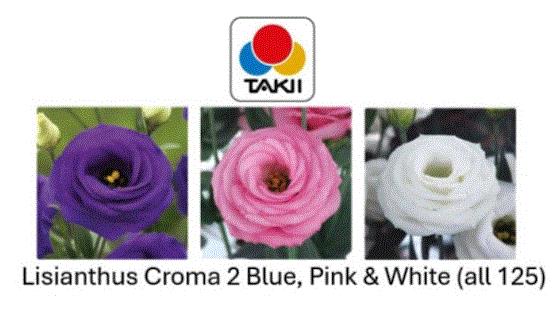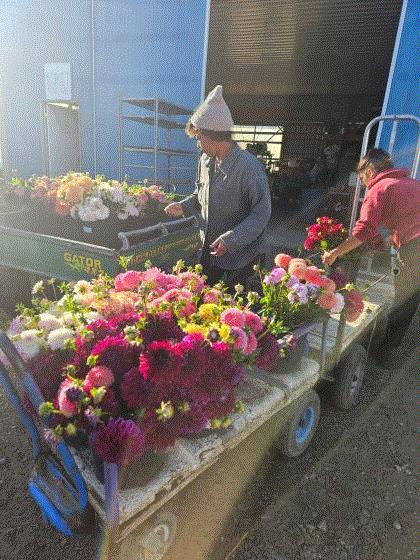End-of-November Farm Update

Trying to soak in the last armloads of fall flowers. Highlights include
Crimson Tide mums and COCO Marigolds.
Happy Thanksgiving! Tater and I hope your fall cleanup is complete and your dahlias are safely tucked into storage. Here at Forget Me Not we are finishing fall flower season with some of the last succession of oriental lilies, marigolds and chrysanthemums.
We planted a lot of white and burgundy snapdragons this season. The end of November is tough—after Thanksgiving, florists are done with oranges and bronze colored flowers and they immediately shift into holiday season—lots of whites, burgundy and red. So Tater and I decided to play it safe and sow heavy on burgundy, peaches and whites. So far it seems to work out well. It’s a safer approach than ending up with too many orange snapdragons on December 1.
Tater and I are looking forward to the downshift from fall flowers to the winter planning season. We’re not only thinking about our crop plan, but our hiring plan as well. We had a few bottlenecks during critical points of the season, and I hope some advance planning will set us up for success for 2026. Farming is a marathon, not a sprint. We had a lot of wins this season that I am incredibly proud of. But the more seasons we farm, the more I realize that we can improve on what we do. And the best way to improve is by recruiting the right talent.
In this edition of Bloom Beat, we’re introducing Ball’s New Cut Flower Collections, hiring wins and woes, and more.
With all that being said, let’s talk shop!

New Cut Flower Collections from Ball
Ball Cut Flowers have three new curated collections for us cut flower growers. These collections showcase new varieties from Pan American Seed, Takii and Sakata.
The Takii 2026 collection highlights their Croma series of lisianthus in blue, pink and white.

The Pan American collection has celosia Neo Bright Orange, Dianthus Dusty Flamingo and Snapdragon Potomac Bright Orange.
The Sakata collection is also exciting. It showcases their new Azumi XL Pink asters, Solo light pink lisianthus and the infamous Snapstar Champagne Snapdragon!
Shout out to Ball for getting their hands on some of Sakata’s Snapstar Champagne seeds. It’s one of the most beautiful snapdragons I have ever grown. Tater and I are excited for you to try them, especially since Snapstar isn’t commercial yet in the states. That’s another reason why you should order a box!
Be sure to order them before they sell out. Order these on WebTrack, or talk to your Ball Seed or Ball ColorLink rep. Click
HERE for more information.

Cornell Extension Cut Flower Webinar Series

Looking for more educational opportunities this winter from the comfort of your couch and fuzzy pajamas? Cornell Cooperative Extension announced the dates for its fifth annual CCE Cut Flower Webinar Series. Sessions will be on Tuesday afternoons starting January 6 through February 3. Topics include disease and pest management, propagation techniques, market trends and more! Tater and I are eager to tune into these. We hope you will join us!
You can register for individual sessions for $20 each or register for all five for just $60. You can use
THIS LINK to register.
The best part is, you will receive a link to the webinar recordings for future reference. Partial scholarships are available to extension educators of Cornell Cooperative Extension and extension educators in other states.
For more information on the scholarship you can reach out to Jingjing Yin via
EMAIL.
Staffing Considerations for Next Season

Your team is your best asset. It takes time and effort to build it.
In my opinion, fall cleanup is just as busy as spring planting. Between mowing down the fields, picking up field plastic, digging dahlias, steaming soil and planting in the greenhouses, it’s a busy time. But to be honest, running around like a chicken with your head cut off every day in September, October and November gets old very quickly, and the hustle and bustle of fall reminds me that I need to reevaluate our staffing needs for 2026.
Staffing was a challenge this season, mostly because we increased our dahlia and field production by double. Some of the folks we hired earlier in the season weren’t a great fit, and we didn’t have much luck filling the seasonal positions half through the summer. This was the first season I truly felt critically understaffed, so I am taking a more strategic approach this winter to fix this.
There is no quick and dirty recipe for calculating staffing. But if there were tasks this season that you felt were overbearing for you and your team, it’s worth writing down how long it took you to accomplish these tasks and create a hiring plan to address the ebb and flow of work on your farm. In case you need a framework, or are on the fence as to whether you need more staffing, here are some things to consider while you are evaluating your long term staffing needs:
- Were there points in the season where crop quality decreased or planting successions were missed? This could be an indicator that your team is stretched too thin.
- Did you and your team struggle to respond to messages, phone calls or address customer complaints in a timely manner?
- Are you and your team consistently stressed?
- Are there opportunities in the market that you can’t pursue due to staffing?
- Are there skill gaps in your current team that you can hire a specialist to take over?
- Are you turning down orders because you don’t have the production or man power?
In my opinion, if you answered yes to three or more of these it’s time to create a hiring plan and budget for 2026. Another option to consider is using a staffing service. Tater and I have not used one of these but I know of other farms who have (some positive and some negative). But I think it is worth considering, especially if you lack critical staffing for a particular task for a week or two, such as dahlia digging or fall clean up. Granted, this a short-term solution, but it can get you through a tight spot. It may be worth connecting with a firm in your area this winter to get more details.
How was your staffing this season? Tater and I would love to hear your experiences and thoughts. Click
HERE to drop us a line.

All About Job Descriptions

Take some time this winter to lay a strong framework for hiring next season/
While you are evaluating your hiring needs for 2026, it’s important to write a job description that will attract the kind of talent you are looking for—and to do it while the bottlenecks are fresh in your mind! Remember, job descriptions are tools that help you define roles, responsibilities, and tangible metrics of performance. Treat this just like your crop plan.
In my experience, comprehensive job descriptions are the best way to find a great fit for your farm. They eliminate the rose-color-glasses view of flower farming that is oh so prevalent on social media! The colorful images and breathtaking videos paint a romantic and somewhat whimsical picture—which isn’t always a bad thing for getting people in the door (customers or employees). But it is also important to widen the lens for interested applicants so that they understand the breadth of the work involved—AKA eliminate the Instagram filter! Growing and cutting flowers is hard physical work. A properly written job description allows you to communicate the daily working conditions and your expectations of prospective employees.
That is why job descriptions are powerful tools. Applicants know ahead of time what the job will entail. I encourage you to use language such as, “Must be able to lift X lbs.” and/or "Must be able to stand, crouch and bend over for extended periods of time.”
As you craft your job description, I encourage you to be as specific as possible. For those of you writing your first job description, check out this
ARTICLE from the University of Wisconsin. It describes each part of the job description and is a great introduction to the process. Do NOT just copy and paste another farm’s job description or use ChatGPT. Take the time to customize it and make it fit your farm. Also, if your job description is well-written, once you hire someone, it can also be used to assess employee progress.
• Make your job title count. It should be descriptive, accurate and eye-catching. Use searchable key words.
• Make your job description easy to read. Bulky paragraphs can be hard to process. Use bullet points when possible—that way, candidates can quickly determine whether your position is a fit. It'll save you a lot of time during the interview process if unsuitable candidates weed themselves out before they apply.
• Write how you talk.
• If you want to add a short description of your farm, put it at the end.
• Evaluate what qualifications are essential. This is where you can qualify what physical or educational requirements are needed or what prior experience may be equivalent.
Tater and I hope you find your perfect candidates next season! Hiring is an art and a skill that is honed slowly over time. Be sure to earmark the time this winter to plan and recruit the talent you need for next season and beyond.

We're Cheering for You!
Lindsay Daschner (and Tater)
Editor-at-Large—Bloom Beat
Owner—Forget-Me-Not Farms
This email was received by 6,236 of your fellow fresh-cut flower growers!
If you're interested in advertising in Bloom Beat, contact Kim Brown and she will hook you up!